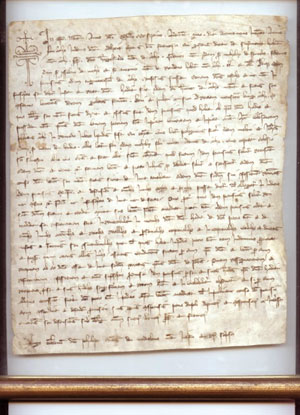 Of all the great stories, this story involving a Knights Templar document, particularly touched me.
Of all the great stories, this story involving a Knights Templar document, particularly touched me.
BB’s mother taught English as a Second Language at UCSB until well into her 90’s. She took all her students under her wing, became known to many as “Grandmother.” As a respected member of their families, when the kids returned home, they often remembered their state-side grandmother with special rare gifts from their home countries.
Now that their mother passed, BB and her sister inherited some treasures. None the least is this manuscript appearing to be on animal skin, and BB thinks it’s written in Latin and may come from Italy. The student’s family who sent it attached a card to the back of this framed piece. Old itself, the card is signed by a Serenella Pirovano Discacciatai, and gives a number “116” written in a different hand directly on the back of the parchment. This number seems like a catalogue number as the card attached refers to this parchment as a part of a collection.
BB told me she knows two things: Someone thought it valuable enough to assign a “call letter.” BB believes this might be as old as 1700 because that’s when things might have been written on parchment. Back then historians estimate that less than 30 percent of folks recognized something written. So that made BB curious about what she calls her ancient “grocery list.”
The best is yet to come… I told BB.
If you, dear reader, know more about this than i explain in what follows, i hope you email me with what you know. I have an (educated) intuition that this is something special. But how special, exactly?
I see a faint date of what I think says 1307 at the very top. At the bottom of the letter I see a faint signature of “Philip.” I did a search of notable historic events for 1307 to connect the date and the name. Lots went on in 1307. William Tell shoots an apple off his son’s head, no, that’s not it. Albrecht the First makes his son King of Bohemia, then a cousin named Henrik takes over as King of Bohemia, no that can’t be it either.
But look! The Knights Templar
On October 13, 1307 the French King Philip IV convicts the Knights Templar of heresy. WOW!
in 1120 eight Christian knights, ordained in the Latin Kingdom of Jerusalem, took on the job of protecting pilgrims as they traveled to and from Jerusalem. These Templars, a secret society, followed the Rule of the Order: Obedience, Poverty and Chastity. But that didn’t preclude battling, and they fought on the side of big money during the Crusades and fought for the Holy Land against “Infidels.” The Knights Templar became the day’s mercenary soldiers paid to defend kings and nobles, and exempt from rules, taxes, and, some said, moral behavior.
By 1307, the date of this document, people hated them for having more money and influence than even the king.
To make a long complex history shorter
The Knights loaned the French King Philip money, a lot of it, in that time. Philip’s capitol Paris revolted against him. Philip appeared as a big spender and the common peoples’ bread was in scarce order. Yet the Templars defended Philip. The Pope at the time wrote a letter to Philip in 1307 asking for permission to investigate the Templars. But the crafty, and in their debt, Philip, without the Pope’s permission seized as many Knights as he could and threw them in prison.
Also in 1307 more documents appeared to all bailiffs of the kingdoms of France, England, Iberia, Germany, Italy and Cyprus. These letters asked representatives of these countries to grab the Templars, arrest them, torture them. Again in 1307 the Pope himself jumped on the bandwagon of the inquisition destruction and forced the two main leaders of the Templars to “confess.”
How many confessed seems close to 100 Knights, of which 54 were burned at the stake in Paris in 1310. The Order finished off in 1314 when the two very highest leaders of the Knights burned at the stake.
Could this document be one of those letters which directed officials to capture the Templars, coming from Philip himself?
Historical documents relating to the Knights Templar recently turned up
A famous example is the Chinon Parchment, discovered in 2001 in the Vatican Secret Archive. The historian who studied letters between Philip and the Pope assumed existence of this document long before its discovery.
Now for the GREAT BIG THING as relates to BB. Historians know that eventually someone will find one missing link in the story of the demise of the Knights Templar. The historian who found the Chinon document in 2001 surmises she’ll eventually find another document which may deal with the charges of secret initiation practices of the Templars.
I wonder if anyone can help BB find out if this is the missing link?